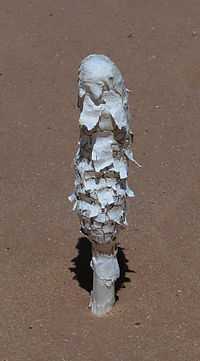Podaxis
| Podaxis | |
|---|---|
 | |
| Podaxis pistillaris | |
| Scientific classification | |
| Kingdom: | Fungi |
| Phylum: | Basidiomycota |
| Class: | Agaricomycetes |
| Order: | Agaricales |
| Family: | Agaricaceae |
| Genus: | Podaxis Desv. |
| Type species | |
| Podaxis senegalensis Desv. | |
Podaxis is a genus of secotioid fungi in the family Agaricaceae. Species, which have the appearance of a "stalked-puffball", have a worldwide distribution, and tend to be found growing solitary or scattered on sandy soils, especially in arid regions. Although close to 50 species have been described, it has been argued that many of them may represent extremes in the natural range of variations found in Podaxis pistillaris.[1]
Description
Fruiting bodies have the appearance of an unopened Coprinus comatus, with a stipe and a loose, brown to blackish powdery gleba at maturity. Basidiospores are obovate, thick-walled with a large apical pore, and typically 10-17 x 9-12 µm in size.[2] Clamp connections are present.[3]
Podaxis is a common inhabitant of soil and termite mounds throughout the drier regions of the tropics and subtropics of the world.[4] P. pistillaris is a ground-inhabiting species, but most Podaxis species in the rest of the world are associated with termite mounds. This includes the Australian species P. beringamensis.[5]
Taxonomy
The genus was originally named Podaxis and described by Nicaise Auguste Desvaux in 1809,[6] while Elias Magnus Fries later (1829) called the taxon Podaxon.[7] Although a number of articles have used the latter name, Podaxis is the preferred name as it has nomenclatorial priority due to its earlier appearance.[1]
Early suggestions[2][1][8] that Podaxis was related to the genus Coprinus were later confirmed using phylogenetic analysis based on sequence data of rDNA genes.[9][10] This research showed that Podaxis is in a clade with the species Montagnea arenaria and Agaricus pocillator, and the genus Leucocoprinus. For this reason, Podaxis was transferred to the family Agaricaceae (order Agaricales) from the now obsolete family name Podaxaceae (order Podaxales).
A section of Podaxis, named Parvispora, was circumscribed to accommodate three species (P. argentinus, P. longii and P. microsporus) with small spores.[11]
Uses
The dark purple spores of Podaxis species are used by Australian aborigines as a face paint.[12] Podaxis aegyptiacus is used as a common traditional medicine in the Bamako region of Mali for wound-healing, and water extracts from the mushroom have been shown to have carbohydrates with beneficial effects on the immune system in vitro.[13]
References
- ↑ 1.0 1.1 1.2 Morse EE. (1933). A study of the genus Podaxis. Mycologia 25(1): 1-33.
- ↑ 2.0 2.1 Miller, Hope Ridings; Miller, Orson K. (1988). Gasteromycetes: morphological and developmental features, with keys to the orders, families, and genera. Eureka, Calif: Mad River Press. ISBN 0-916422-74-7.
- ↑ Johnson J. (1999). Phylogenetic relationships within Lepiota sensu lato based on morphological and molecular data. Mycologia 91(3): 443-458.
- ↑ http://cms.jcu.edu.au/discovernature/fungi/JCUDEV_017269
- ↑ Priest MJ, Lenz M. (1999). The genus Podaxis (Gasteromycetes) in Australia with a description of a new species from termite mounds. Australian Systematic Botany 12(1): 109-116.
- ↑ Desvaux NA. (1809). Observations sur quelques genres a etablir dans la famille des champignons. Podaxis senegalensis. Jour. de Bot. 2: 95-97.
- ↑ Fries EM. (1829). Podaxon. Syst. Orb. Veg. 1: 159.
- ↑ Watling R. (1978). From infancy to adolescence: advances in the study of higher fungi. Transactions of the Botanical Society of Edinburg 42(supplement): 61-73.
- ↑ Hopple JS Jr, Vilgalys R. (1994). Phylogenetic relationships among coprinoid taxa and allies based on data from restriction site mapping of nuclear rDNA. Mycologia 86(1): 96-107.
- ↑ Hopple JS, Vilgalys R (October 1999). "Phylogenetic relationships in the mushroom genus Coprinus and dark-spored allies based on sequence data from the nuclear gene coding for the large ribosomal subunit RNA: divergent domains, outgroups, and monophyly". Mol. Phylogenet. Evol. 13 (1): 1–19. doi:10.1006/mpev.1999.0634. PMID 10508535.
- ↑ McKnight KH. The small-spored species of Podaxis. Mycologia 77(1): 25-35.
- ↑ Cleland JB, Johnston TH. (1933). The ecology of the aborigines of Central Australia; botanical notes. Transactions and Proceedings of the Royal Society of South Australia 57: 113-124.
- ↑ Diallo D, Sogn C, Samake FB, Paulsen BS, Michaelsen TE, Keita A. (2002). Wound healing plants in Mali, the Bamako region. An ethnobotanical survey and complement fixation of water extracts from selected plants. Pharmaceutical Biology 40(2): 117-128.